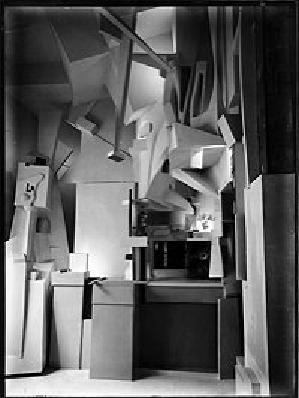Kurt Schwitters
dal 3/5/2004 al 22/8/2004
Segnalato da
3/5/2004
Kurt Schwitters
Tinguely Museum, Basel
The original works of Kurt Schwitters (1887 - 1948) since 1971. About 150 loans from international museums and many privately owned works that are very seldom on public display. At the heart of the exhibition is Schwitters' masterpiece and culmination of his idea of a total art work: the Merzbau (Merz building), a monumental three-dimensional assemblage progressively created from 1923 onwards in the artist's studio and home in Hanover. On display is a walk-in reconstruction of the original Merzbau, which was entirely destroyed in 1943. The reconstruction was built by Peter Bissegger, on the initiative of Harald Szeemann, using original photographs. It is complemented by photographic and textual records, as well as selected reliefs, collages and sculptures from the late 1920s, casting light on the way in which Schwitters was influenced at the time by constructivist tendencies.

MERZ - a total vision of the world
With about 150 loans from international museums and many privately owned works that are very seldom on public display, this exhibition at the Tinguely Museum is the first opportunity for people in Switzerland to see the original works of Kurt Schwitters (1887 - 1948) since 1971.
Although relatively unknown in Switzerland, Kurt Schwitters is among the outstanding artistic pioneers of the first half of the 20th century. After the First World War he made the provocative statement that ''one can use waste material to shout out loud'', and from then on he employed everyday materials and objets trouvés in his collages and assemblages. In 1919 he invented his own artistic movement, Merz; the term is taken from the bank name ''Kommerz- und Privatbank''. From now on he grouped together all aspects of his very varied artistic activities - painting, sculpture, architecture, poetry, drama, typography and happenings - under the heading of Merz.
With his programmatic idea of a ''total Merz vision of the world'', embracing all areas of life and art, he set an example for the thinking and creative work of many artists of the post-war generation. Together with Marcel Duchamp, Kurt Schwitters was Jean Tinguely's most important artistic role model: ''I was ? completely schwittered, Schwitters was my hero,'' said Tinguely.
At the heart of the exhibition is Schwitters' masterpiece and culmination of his idea of a total art work: the Merzbau (Merz building), a monumental three-dimensional assemblage progressively created from 1923 onwards in the artist's studio and home in Hanover. On display is a walk-in reconstruction of the original Merzbau, which was entirely destroyed in 1943. The reconstruction was built by Peter Bissegger, on the initiative of Harald Szeemann, using original photographs. It is complemented by photographic and textual records, as well as selected reliefs, collages and sculptures from the late 1920s, casting light on the way in which Schwitters was influenced at the time by constructivist tendencies. There are further documentary records of the artist's other three Merzbau projects, now also destroyed, which he created while in exile in Norway and Great Britain.
Displays in four more rooms illustrate the artist's idea of Merz art, which transcends separate genres; they include Merz drawing and Merz paintings from his entire creative life, early lithographs, stamped drawings and Dadaist watercolours from the twenties, his ''i-drawings'' made from printers' waste, as well as the journal Merz that he edited and designed, and his Ursonate (primeval sonata). Arranged in thematic groups, the exhibition includes the following aspects, which are also central to Tinguely's work: the principles of collage and montage; a satirical approach to the machine age through the use of motifs and materials drawn from everyday technological and urban life; reliance on chance; the use of industrially manufactured materials as an artistic medium; and the evocation of ambiguous and cryptic associations through which viewers themselves become part of the artwork.
As well as documentary records, the exhibition contains about 150 loaned items. These include exquisite collages, fragile assemblages which are seldom lent out, reliefs and ten sculptures. Many works come from private collections and often have not been publicly exhibited for decades: they include tributes to Carola Giedion-Welcker, Jan Tschichold, Friedrich Vordemberge-Gildewart, and special items from the collections of Willi Baumeister, Max Bill and Jasper Johns. From private possession come the important Bäumerbild (1920), the Heilige Sattlermappe (1922), fine reliefs like the Richard Freytagbild (1927), and Violinschlüssel (1923/27). Galleries that have promoted the work of Schwitters, such as Kornfeld, Marlborough, Janis and Gmuzynska, have also made a major contribution. Other important works come from the Kunstmuseum of Berne, the Wilhelm-Hack-Museum of Ludwigshafen, the Kunstmuseum of Winterthur and Zug, the Musée d'art et d'histoire of Geneva, the IVAM, the Centre Julio González of Valencia, the Musée d'Art Moderne et Contemporain of Strasbourg and the Muzeum Sktuki of Lodz, the Nationalgalerie in Berlin, the Museum of Modern Art in New York, and the Menil Collection of Houston. Some 40 works, including the reconstruction of the Merzbau, have been made available to us as the nucleus of our exhibition by our ''partners'', the Sprengel Museum of Hanover and the Kurt and Ernst Schwitters Foundation connected with it.
Another area of the exhibition presents Tinguely's idea of the walk-in structures that he called ''multicultural and multifunctional sculptures of experience'', which were strongly influenced by Schwitters with his Merzbau and Merz drama. At the heart of this section is a large-screen cinematic projection of the Cyclop in the woods at Milly-la-Forêt, as well as drawings, models and photographs of the various ''cultural stations'' on which Tinguely and his artist friends worked from the early 1960s onwards.
But above all, our Schwitters exhibition shows how the artist succeeded in creating new pictorial beauty from the fragments of a ruined world and from everyday materials.
A lavishly illustrated catalogue to the exhibition, in both German and English, is published by Benteli Verlag, Bern, c. 264 pages, price CHF 59.00
Museum Tinguely
Paul Sacher-Anlage 1 Postfach 3255 CH-4002 Basel



